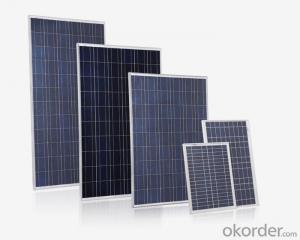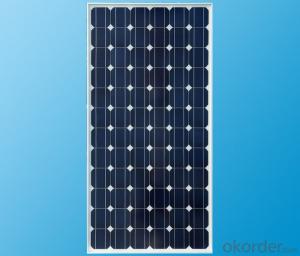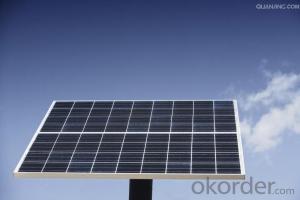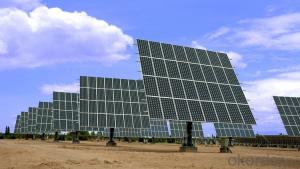Favorites Compare 100w monocrystalline solar panel price
- Loading Port:
- China Main Port
- Payment Terms:
- TT OR LC
- Min Order Qty:
- -
- Supply Capability:
- 10000000000000 watt/month
OKorder Service Pledge
OKorder Financial Service
You Might Also Like
Quick Details
| Place of Origin: | Guangdong China (Mainland) | Brand Name: | CAP | Model Number: | 50w100w150w200w250w300w |
| Material: | Monocrystalline Silicon | Size: | 1385*1035*75mm | Number of Cells: | 72pcs |
| Max. Power: | 300w | type: | solar panel | color: | blue&black |
| warranty: | 5 years |
Packaging & Delivery
| Packaging Detail: | standard export package for solar panel |
| Delivery Detail: | 7-15 days for solar panel |
Specifications
solar panel
High Efficiency
25 years Warranty
High-transmissivity low-iron tempered glass
Solar Panel
50w100w150w200w250w300w
Characteristics
1,High and stable conversion efficienly based on over 4 years professional experience
2 ,High reliability with guaranteed +/-10% output power tolerance
3,Proven materials,tempered front glass,and a sturdy anodized aluminum frame allow modules to operate reliably in multiple mountily configurations
4,Combination of high efficicncy and attractive appearance
Quality and Safety
1,25 year 80%,10 year 90% power warranty 3 year power warranty
2,ISO9001:2000 (Quality Management system) certified factory
3,Product Quality warranty & products Liability Insurance to guarantee and user' benefits
4,Certifications TUV Intercert, CE Temperature Coefficients
| Module Type | 100w | 150w | 200w | 250w | 300w |
| Maximum Power at ST(Pmax)W | 100wp | 150wp | 200wp | 250wp | 300wp |
| Maximum Power Voltage(Vmp)V | 36/18 | 36/18 | 36/18 | 30.8v | 36/18 |
| Maximum Power Current(Imp)A | 2.77/5.55 | 4.16/8.33 | 5.55/11.1 | 8.11A | 8.33/16.66 |
| Open Circuit Voltage(Voc)V | 39.5/19.05 | 39.3/19.4 | 39.6/19.5 | 36.2V | 39.6/19.8 |
| Short Circuit Current(Isc)A | 3.04/6.09 | 4.58/9.16 | 6.1/12.2 | 8.7A | 9.16/18.33 |
| Cell Efficiency(%) | 18.60% | 18.10% | 18.60% | 17.80% | 18.10% |
| Module Efficiency(%) | 17.70% | 17.20% | 17.70% | 17.10% | 17.20% |
| Operating Temperature°C | -40°C to +85°C | -40°C to +85°C | -40°C to +85°C | -40°C to +85°C | -40°C to +85°C |
| Maximum system voltage | 1000V(IEC)DC | 1000V(IEC)DC | 1000V(IEC)DC | 1000V(IEC)DC | 1000V(IEC)DC |
| Power tolerance | -0.03 | -0.03 | -0.03 | -0.03 | -0.03 |
| Temperature coefficients of Pmax | -0.45%/°C | -0.45%/°C | -0.45%/°C | -0.45%/°C | -0.45%/°C |
| Temperature coefficients of Voc | -0.27%/°C | -0.27%/°C | -0.27%/°C | -0.27%/°C | -0.27%/°C |
| Temperature coefficients of Isc | 0.05%/°C | 0.05%/°C | 0.05%/°C | 0.05%/°C | 0.05%/°C |
| Weight(kg) | 8 | 11 | 14 | 20 | 25.5 |
| Number of cell(pcs) | 4*9 | 4*9 | 6*10 | 6*12 | 6*12 |
| Dimensions(mm) | 1194*534*35/30 | 1580*808*50/35 | 1471*670*40/35 | 1640*992*50 | 2000*1050*50 |
- Q:What is the role of solar cells in powering remote monitoring systems?
- Solar cells play a crucial role in powering remote monitoring systems by converting sunlight into electricity. These systems are often installed in remote locations where access to traditional power sources is limited or non-existent. Solar cells provide a sustainable and reliable source of energy to continuously power these systems, allowing for continuous monitoring and data collection even in remote areas.
- Q:Is it possible to learn how to make solar cells by yourself?
- A solar cell can be made very simply by using a sheet of copper and some other materials. So the answer is yes!
- Q:Briefly explain why solar cells are made into components
- The main photovoltaic material is the crystalline silicon material (including polysilicon and monocrystalline silicon), this material is high hardness, brittleness, uneven force easily brittle, exposed to the air easily oxidized, and the use of the process can not
- Q:How do solar cells perform in areas with high levels of snowfall?
- Solar cells typically do not perform optimally in areas with high levels of snowfall. The accumulation of snow on the surface of the cells can block sunlight and reduce their efficiency. However, advancements have been made to design solar panels with self-cleaning features or tilted angles that can help shed snow. Additionally, regular maintenance and clearing of snow can help ensure the continued performance of solar cells in such areas.
- Q:Can solar cells be used in oil and gas exploration?
- Yes, solar cells can be utilized in oil and gas exploration. While they may not directly contribute to the exploration process, solar cells can be employed in supporting infrastructure and operations. Solar-powered equipment such as remote monitoring systems, communication devices, and data collection instruments can be used in remote or off-grid locations, enhancing efficiency, reducing reliance on fossil fuels, and minimizing environmental impact.
- Q:What is the impact of solar cells on reducing noise pollution from power generation?
- Solar cells have a minimal impact on reducing noise pollution from power generation as they operate silently, in contrast to traditional power generation methods such as fossil fuel-based power plants or wind turbines, which can be noisy.
- Q:Can solar cells be used for powering security systems?
- Yes, solar cells can definitely be used for powering security systems. Solar panels can convert sunlight into electricity, providing a renewable energy source to power security cameras, alarms, and other security devices. This eliminates the need for a constant electrical supply or batteries, making it a cost-effective and environmentally friendly solution for powering security systems.
- Q:What is the maintenance required for solar cells?
- The maintenance required for solar cells is typically minimal. It involves regular cleaning of the solar panels to remove any dust or debris that may accumulate and potentially reduce their efficiency. Additionally, periodic inspections are recommended to detect any signs of damage or wear, such as cracked glass or loose connections, which should be repaired promptly. Overall, proper maintenance ensures optimal performance and longevity of solar cells.
- Q:How much energy can a solar cell generate?
- The amount of energy a solar cell can generate depends on various factors such as its size, efficiency, and the amount of sunlight it receives. On average, a solar cell can generate anywhere from a few watts to several hundred watts of power.
- Q:What is the size and weight of a typical solar cell?
- The size and weight of a typical solar cell can vary depending on its application and design. However, a common size for residential solar panels is around 65 inches by 39 inches, with a weight of approximately 40 pounds.
1. Manufacturer Overview |
|
|---|---|
| Location | |
| Year Established | |
| Annual Output Value | |
| Main Markets | |
| Company Certifications | |
2. Manufacturer Certificates |
|
|---|---|
| a) Certification Name | |
| Range | |
| Reference | |
| Validity Period | |
3. Manufacturer Capability |
|
|---|---|
| a)Trade Capacity | |
| Nearest Port | |
| Export Percentage | |
| No.of Employees in Trade Department | |
| Language Spoken: | |
| b)Factory Information | |
| Factory Size: | |
| No. of Production Lines | |
| Contract Manufacturing | |
| Product Price Range | |
Send your message to us
Favorites Compare 100w monocrystalline solar panel price
- Loading Port:
- China Main Port
- Payment Terms:
- TT OR LC
- Min Order Qty:
- -
- Supply Capability:
- 10000000000000 watt/month
OKorder Service Pledge
OKorder Financial Service
Similar products
New products
Hot products
Hot Searches
Related keywords



























